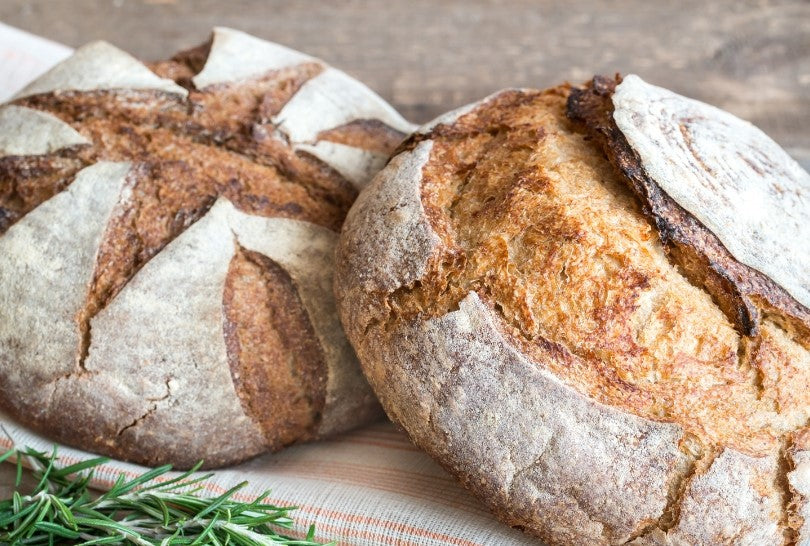
Sourdough: Rediscovering What Bread Is Supposed to Be
Share
PLANTIVA HEALTH BRIEFS
Sourdough: Rediscovering What Bread Is Supposed to Be
Sourdough is perhaps the oldest bread known to mankind after flatbread. And whereas modern bread is largely “empty calories,” sourdough is so nutritious that ancient man could survive on a diet consisting largely of bread!
Making sourdough includes a long, often multi-day fermentation period during which a complex mixture of wild yeasts and bacteria not only produce carbon dioxide to leaven the dough, but also significantly alter the chemical makeup of the dough.
And there’s data to show these chemical changes make sourdough much healthier than modern breads leavened with commercial yeast or chemical raising agents.
- For one thing, sourdough breads have lower levels of gluten than their modern counterparts, which makes the bread easier to tolerate for people who are sensitive to gluten.
- They also have higher levels of dietary fiber, which acts as a prebiotic to feed beneficial gut bacteria in the intestinal microbiome.
- The mineral content in sourdough bread is more easily assimilated than in modern breads, probably because sourdough contains lower levels of phytic acid which binds to minerals like iron, magnesium, and calcium and is known to make the bound minerals less available to the body.
- Sourdough fermentation increases the levels and diversity of amino acids in the dough, making sourdough a better source of protein than its modern counterpart. Some types of sourdough are nearly a complete protein all by themselves!
- Perhaps most importantly in the context of modern-day diets, sourdough fermentation lowers the glycemic index (GI) of the bread, meaning sourdough produces a lower spike in blood glucose levels than the same bread made with commercial yeast.
This smaller increase in blood glucose is quite important since elevated blood glucose is linked to diabetes, obesity, high blood pressure, liver disease, cardiovascular disease, and many of the other ailments that plague us.
“Those persons who are dieted upon fermented bread are stronger in body.”
– Pliny the Elder, AD 77-79
However, as with everything food-related, the devil is in the details!
While sourdough is generally more nutritious and has a lower GI than modern breads, the numbers vary quite a bit depending on the details of the recipe and fermentation used.
Some "sourdough" breads are made just like modern bread but with added acid to achieve a sour taste – these are basically fake sourdough. And sourdough made with white flour may or may not have a lower GI than modern bread made with whole wheat flour.
Data on the glycemic index of many commercial breads is available at: International tables of glycemic index and glycemic load values 2021: a systematic review (see in particular the Supplemental Tables).
As a general guideline, we suggest looking for sourdough that –
- Lists “sourdough starter,” “sour culture,” or "levain" as one of the ingredients;
- Does not list yeast, baking powder, baking soda, etc. in the ingredients;
- Does not contain added sugar, honey, or similar sugary sweeteners;
- Is made using a prolonged fermentation time, preferably at least 24 hours;
- Is made using freshly-milled flour.
If your body tolerates whole grains, then sourdough made with whole grains will provide more nutrition and will generally have a lower GI than white flour. (If you think your body doesn’t tolerate whole grains, it may be worth experimenting with some whole grain sourdough – you may find that you tolerate it much better than you expect.)
In addition, as with any fermented food, you may find that you tolerate some brands better than others depending on the types of microbes present in the fermentation. You’ll need to evaluate your individual response to any given brand.
Or if you’re adventurous, try making your own sourdough bread! We like to make it with equal parts whole wheat and white organic flour. Try adding nuts and seeds, or soaked dried fruit. If you know anyone with sourdough starter they can easily share it with you. You can also get free starter from Carl's Friends, which has been kept alive since it was used in the mid 1800’s on the Oregon Trail. And you can always make your own – either a simple flour one or one using fruit, which many believe produces superior results.
Sourdough bread is truly a health and nutrition powerhouse. And many people prefer its flavor to the blandness or sugary sweetness of modern breads. We encourage everyone to find a type of sourdough that their body appreciates.
It's bread the way bread was meant to be!

3 comments
Hi Dorothy, That bread looks amazing, doesn’t it!?! Unfortunately we don’t sell any bread, although we do have an employee who is a great baker. We hope to offer some kinds of baked goods eventually at our store. Thanks for your comment and question! – Plantiva
Do you sell your bread
Great information. Thank you